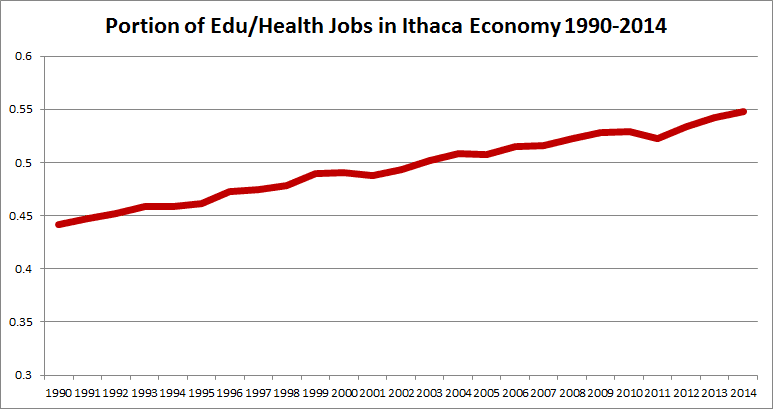Part I looked at how in the past 25 years, Ithaca and Tompkins County had their keisters handed to them by a deep 1990s recession, but came out of the Great Recession of the late 2000s nearly unscathed. Part II provided a break down of job growth by BLS sectors – some sectors, like manufacturing and trade, have given way over the years to a workforce increasingly made up of engineers, scientists and social activists.
However, two big attractions have yet to be discussed – “Government” and “Education and Healthcare”. Those will be covered here in Part III.
At left is the plot of jobs from 1990 to 2015 in the “Government” sector. Cue the sharpening of the pitchforks. Yes, the token government bureaucrat falls in this category. So do police officers, firefighters and military personnel. The sector shrank briefly in the early 1990s and has grown or held steady since. But in the 2000s recession, there’s an enormous boost – from November 2008’s 9,000 jobs to January 2010’s 10,300. The sector maxed at 10,400 jobs, over 15% of the local market, in October and November 2011. The annual average number of government jobs that year was 10,000, and it has fallen steadily since, with last year’s annual average total of government jobs being about 9,100.
Now the proverbial juggernaut, “Education and Health Services”. Cornell, Ithaca College, TC3, ICSD and other local school districts, as well as doctors, nurses and so forth. Just how much of the local economy does this sector comprise? I plotted it out in annual average proportions below.
Since 1990, it’s climbed from about 45% of the total job market to 55% of the total job market. The colleges and university by themselves account for nearly 10,000 jobs. In the BLS plot, the sector shrinks a little in the early 1990s, but then it’s climbed ever since, though with a strong amount of seasonality as a result of the academic year.
Now back to the recession question. If Cornell cut hundreds of jobs, and IC didn’t really grow (according to their own reports), what helped cosset Ithaca from the economic maelstrom a few years ago? Why did it do so much better in the 2000s than the 1990s?
The other half of that economic sector. Healthcare.
It’s no big secret that healthcare has been a big grower in the county for the past several years. The local healthcare industry was essentially untouched by the 2000s recession. Cayuga Medical Center has added over 500 jobs since 2008. Baby Boomers are retiring in large numbers, and they expect a full suite of healthcare services; and while the Boomers are generally fleeing this state by the truckload for warm, low-tax locales like Florida, college towns with a high quality of life, such as Ithaca, are seen as a major draw in their own regard. As more boomers look to a community like Ithaca as an alternative to the golf course-and-shuffleboard crowd, it creates more healthcare job opportunities, which are spearheading job growth in the region.
So there’s the hypothetical conclusion – growth in several small sectors and government helped to offset losses in other sectors during the late 2000s recession, but the real difference between the early 1990s and late 2000s is the growing healthcare market created in large part by an older, retiring population. Health services buoyed the local economy even when Cornell and IC were financially stressed. These days, they all work together to bring job growth to Ithaca and set new record highs in local employment.
Now comes the gut check – does that conclusion make sense? The question was posed to local economists and economic development officials.
“I think your gut is not too far off.” Replied Martha Armstrong, Vice President and Director of Economic Development Planning for TCAD. “Certainly Upstate New York had a prolonged and deep recession in the early 1990s and real estate values took a huge hit, actually losing ground, which was uncommon nationally.”
“Yes, education and health held up well during the great recession, never declining in Ithaca. Ithaca didn’t get involved in the housing bubble or predatory lending. Once the recession ended. Hiring in health and education really took off. As for Cornell’s 700 job cuts [during the recession], that’s 2% of 34,500 jobs in the sector, ” explained Elia Kacapyr, the head of the economics department at Ithaca College and the operator of the Ithaca Business Index. “I can’t confirm it was health care and not education jobs that saved us. The employment figures are combined into one sector. I suspect it was education services. It seems to me education employment dwarfs health in Ithaca. Cornell, Ithaca College, TC3, K – 12.”
Unfortunately, there was no real consensus because the conclusion was unable to be thoroughly proven. A slight disappointment, but for what it’s worth, there is no doubt that Ithaca’s economy handled the latest recession well. Tompkins County is a rare economic bright spot in an otherwise depressed upstate economy.


Very informative series of posts BC. Looks like the Ithaca area needs some employment diversification including better paying (and more challenging) jobs of sorts to match the underemployed folks.